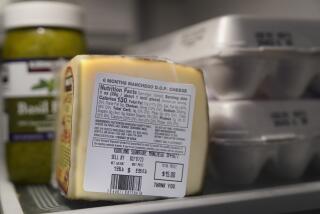Federal Judge Blocks New Chicken Labeling Law : Agribusiness: Ruling lets out-of-state suppliers continue to call their chicken ‘fresh.’ Argument boils down to one degree.
- Share via
A federal judge in Sacramento has issued a preliminary injunction prohibiting California from implementing portions of a law designed to give state chicken producers a tactical advantage over lower-cost, out-of-state producers.
Both the California producers, who pushed for the legislation, and the opposing national poultry trade group said Thursday they found cause to be optimistic about the decision, which was issued Wednesday.
But the weight of Judge David Levi’s ruling seems to favor out-of-state chicken producers, who labeled the state law as “protectionism.” Scheduled to take effect Jan. 1, the law would in effect keep low-cost, non-California poultry concerns from labeling or advertising their product as “fresh.”
Levi’s ruling applied only to the sections of the law regarding labeling.
The injunction comes as part of a lawsuit filed earlier this month by the National Broiler Council, American Meat Institute and Arkansas Poultry Federation. It challenged the new law’s standard for “frozen” chicken, on the basis that it would preempt federal standards, interfere with interstate commerce and hurt out-of-state producers financially.
In essence, the argument is about one degree of difference in the temperature of their chicken products.
The state producers want to be able to call their chicken “fresh” when it has been cooled to 27 or 26 degrees, and the pending law they backed would prohibit out-of-state producers from calling their chicken fresh when it has been cooled to 25 degrees.
(Currently, federal law requires that a poultry product be labeled frozen if it has been cooled to zero degrees or below.)
In order to preserve the chicken during treks across country of up to four days, shippers often cool chicken to 25 degrees or below. California-grown chicken is most often shipped in refrigerator trucks cooled to 26 or 27 degrees because it is delivered to grocers the same day it is processed.
Actually, chicken begins to freeze at 28 degrees. But the California Poultry Industry Federation, spearheaded by the state’s two largest chicken producers, Foster Farms and Zacky, contends that chicken cooled to 26 degrees may be frozen on the outside but remain “fresh” on the inside.
*
However, they argue, chicken cooled to 25 degrees and below becomes “hard as a rock.”
Being able to use the term “fresh” is a major marketing advantage in California’s $2.5-billion annual market for chicken.
The California producers contend that out-of-state producers are able to tap into the consumers’ desire for fresh poultry and charge premium prices, yet still undercut the California producers.
It costs more to raise a chicken for market in California than in any other major poultry producing state, in large part because the cost of feed grain is the most substantial portion--about 60%--of the total cost.
California producers pay much higher rates to have feed grain grown and shipped from the Midwest than do producers in Arkansas and elsewhere in the South.
The state’s chicken producers say that a “fresh” label on chicken shipped from out of state is misleading to consumers.
Yet, it is also possible that chicken grown and processed in California--and labeled fresh according to the new law--could be just as hard-frozen as out-of-state chicken by the time it reaches the grocery cart.
That’s because nothing in current or pending state laws prohibit grocers from cooling “fresh” chicken to below 25 degrees.
More to Read
Inside the business of entertainment
The Wide Shot brings you news, analysis and insights on everything from streaming wars to production — and what it all means for the future.
You may occasionally receive promotional content from the Los Angeles Times.










